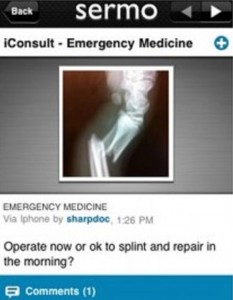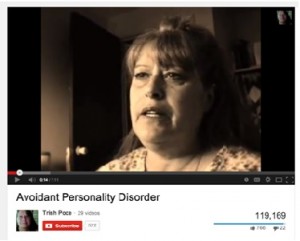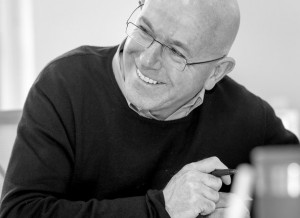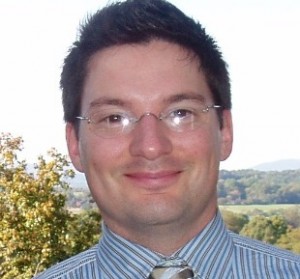The Dartmouth Center for Health Care Delivery Science
How does the increasing interest in the use of crowdsourcing platforms, as a way to help patients, fit into the debate about personal health information and the desire for confidentiality? Social media platforms have redefined how people interact with each other, but could it be that health issues might need to be handled differently? There might well be wisdom in crowds, but how can this be safely harnessed when dealing with health problems? We convened a seminar at Dartmouth, where three short case studies of crowdsourcing relevant to health care were debated. The cases were:
iConsult: Physicians use crowdsourcing for diagnosis and treatment
 Maka Tsulukidze asked whether crowdsourcing expertise could help doctors solve problems. She described the work of Sermo, a company that provides a platform for 200 000 registered qualified doctors. iConsult enables doctors to post questions so that others can reply and comment (see figure).
Maka Tsulukidze asked whether crowdsourcing expertise could help doctors solve problems. She described the work of Sermo, a company that provides a platform for 200 000 registered qualified doctors. iConsult enables doctors to post questions so that others can reply and comment (see figure).
Seminar participants agreed that the platform could be an efficient way to solve clinical problems, particularly for clinicians working in remote areas who do not have easy access to other colleagues. Risks were also raised; for example, where did legal liability rest for advice provided, and what of the risks to participating clinicians, who might be unaware of the full clinical picture or of changing contexts. Questions about the credentialing of the contributors were raised: how secure was the registration process and how sustainable would this form of crowdsourcing be?
An open source cure: The case of Salvatore Iaconesi
 Rachel Thompson talked about Salvatore Iaconesi, a robotic engineer from Italy, who, dissatisfied with the dehumanised approach of the traditional medical system to treating his brain tumour, turned to the crowd for information, advice, and support. In September 2012, Salvatore transformed his medical records into an open access format, and shared them via a dedicated website, La Cura. He invited the world to offer their ‘cures’ for his brain tumour, whether medical, emotional, psychological, or spiritual.
Rachel Thompson talked about Salvatore Iaconesi, a robotic engineer from Italy, who, dissatisfied with the dehumanised approach of the traditional medical system to treating his brain tumour, turned to the crowd for information, advice, and support. In September 2012, Salvatore transformed his medical records into an open access format, and shared them via a dedicated website, La Cura. He invited the world to offer their ‘cures’ for his brain tumour, whether medical, emotional, psychological, or spiritual.
His gesture had radical results. Salvatore was inundated with hundreds of thousands of responses that spanned offers of poetry, patient stories, information from health care professionals, patients’ reviews of many of those same health care professionals, and a myriad of suggestions for responding to his brain tumour. La Cura led to the creation of a community in which information was shared openly and which is valued by its many participants.
Salvatore’s case provoked avid discussion about whether this example of a ‘super-patient’ has wider applications or if it was just the result of a unique and skilled individual. Participants also questioned whether this sort of open source shared record was feasible on a wider scale, especially to patients without the benefit of Salvatore’s skill set. We were left wondering how the benefits that Salvatore had obtained could be achieved more widely given the problems in achieving interoperability between information systems, as well as managing the concerns about privacy.
Can YouTube be a source of help for patients with serious mental illness?
 Stuart Grande showed how YouTube, a platform that allows users to upload videos and post comments online, is being used by patients with mental illness to seek support from others. Videos of patients who had shared their experiences on YouTube were shown. They were selected because of the number of comments other users had posted. The figure on the left shows the first image of a video that received over 100 000 comments. It was made by a woman in her 50s living with a diagnosis of avoidant personality disorder. She spoke about her feelings of being useless and stupid, and how this made her fear being around other people. Comments posted by others echo similar experiences, acknowledging a shared experience, where self doubt led to avoidance of social situations.
Stuart Grande showed how YouTube, a platform that allows users to upload videos and post comments online, is being used by patients with mental illness to seek support from others. Videos of patients who had shared their experiences on YouTube were shown. They were selected because of the number of comments other users had posted. The figure on the left shows the first image of a video that received over 100 000 comments. It was made by a woman in her 50s living with a diagnosis of avoidant personality disorder. She spoke about her feelings of being useless and stupid, and how this made her fear being around other people. Comments posted by others echo similar experiences, acknowledging a shared experience, where self doubt led to avoidance of social situations.
Seminar participants thought the unconstrained nature of YouTube as a platform was useful. It was viewed as a place where peers could share experiences and receive advice. Some participants in the seminar were concerned about the unregulated nature of these interactions, and noted a range of potential risks related to the unhindered give and take from people whose identity cannot be confirmed and whose motives are unknown.
Safety in numbers?
Technologies that enable many people to share almost any aspect of their life online are here to stay, and it is clear that many patients willingly wish to engage and use a range of new platorms for health related issues. The seminar raised more questions than answers: whether contemporary crowdsourcing platforms are a safe and effective medium for a new dimension of healthcare delivery is yet to be determined.
 Glyn Elwyn is a physician-researcher, professor, and senior scientist at The Dartmouth Center for Health Care Delivery Science and The Dartmouth Institute for Health Policy and Clinical Practice.
Glyn Elwyn is a physician-researcher, professor, and senior scientist at The Dartmouth Center for Health Care Delivery Science and The Dartmouth Institute for Health Policy and Clinical Practice.
 Maka Tsulukidze is a postdoctoral fellow at the Dartmouth Center for Health Care Delivery Science.
Maka Tsulukidze is a postdoctoral fellow at the Dartmouth Center for Health Care Delivery Science.
 Rachel Thompson is a health psychology academic whose research focuses on the development, implementation, and evaluation of tools for measuring and facilitating patient engagement and shared decision making.
Rachel Thompson is a health psychology academic whose research focuses on the development, implementation, and evaluation of tools for measuring and facilitating patient engagement and shared decision making.
 Stuart Grande is currently a postdoctoral fellow in shared decision making at The Dartmouth Center for Health Care Delivery Science.
Stuart Grande is currently a postdoctoral fellow in shared decision making at The Dartmouth Center for Health Care Delivery Science.
All authors declare that we have read and understood the BMJ Group policy on declaration of interests and we hereby declare the following interests: Glyn Elwyn provides ad hoc consulting to Emmi Solutions. All other authors have no conflicts to declare.
